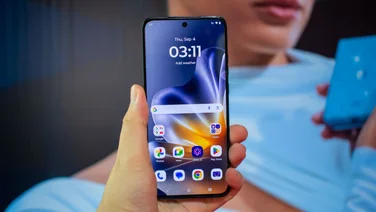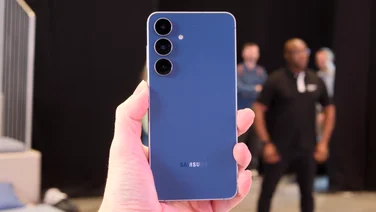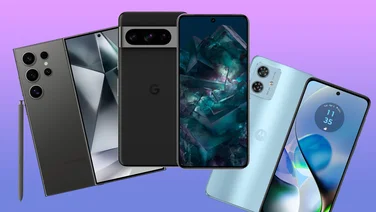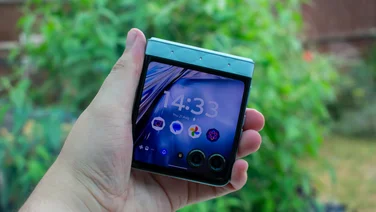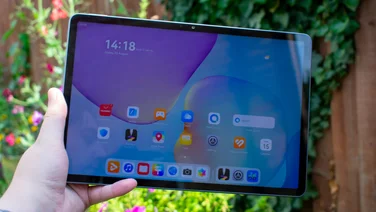To help us provide you with free impartial advice, we may earn a commission if you buy through links on our site. Learn more
- Best mid-range phone: At a glance
- How we test mid-range smartphones
- Best mid-range smartphones you can buy in 2025
- 1. Google Pixel 9a: Best mid-range phone overall
- 2. iPhone 16e: Best mid-range iPhone
- 3. Samsung Galaxy A56: Best mid-range Samsung phone
- 4. Nothing Phone (3a): Best mid-range phone design
- 5. Xiaomi 14T Pro: Best mid-range phone for gaming
- How to choose the best mid-range smartphone for you

With flagship prices regularly stretching beyond £1,000, the best mid-range smartphones are more appealing than ever for those who don’t want to sink four figures on their next phone. And it’s not even much of a concession these days, with the slick designs and impressive hardware of flagship phones steadily trickling down to more affordable models.
We’ve tested and reviewed the best smartphones from all corners of the market and gathered here the finest mid-range handsets for all needs and purposes. We’re constantly getting new iPhones and Android phones in for testing and reviewing, so this list is regularly updated with the newest and most impressive mid-rangers.
If you’re unsure what exactly you’re looking for, our buying guide below has a brief rundown of the features to keep an eye out for. Otherwise, read on to see our picks of the best mid-range smartphones to buy right now.
Best mid-range phone: At a glance
| Best mid-range phone overall | Google Pixel 9a | |
| Best mid-range iPhone | iPhone 16e | |
| Best mid-range Samsung phone | Samsung Galaxy A56 |
How we test mid-range smartphones
When we receive a handset for review, we put it through a variety of tests. The first is performance, where we use two apps on the Apple App Store and Google Play Store: Geekbench 5 and GFXBench. These benchmarking apps provide CPU and GPU processing scores, and allow us to see where the phone fits in against the competition. A phone’s display is tested using our colorimeter and DisplayCAL software, which measures how colour-accurate a screen is, as well as providing maximum brightness and contrast ratio.

Our in-house battery life testing is performed using a looped video via the VLC app, with the screen set to 170cd/m2 brightness and flight mode engaged. We simply record where the video stops when the phone’s battery runs dry. Cameras are tested in a wide variety of lighting conditions, including landscape shots and indoor still life photography, and these images are compared against similarly priced rivals.
Best mid-range smartphones you can buy in 2025
Our most recent update has been a complete overhaul, with last year’s best mid-range phones – the Google Pixel 8a, Samsung Galaxy A55 and Nothing Phone (2a) all replaced by their newer siblings.
Also gone is the Motorola Edge 50 Fusion, simply because it’s been discounted out of this price range. Finally, we’ve added the latest mid-range iPhone, allowing the ageing iPhone SE 3 (2022) to retire in peace at last, and the powerful gaming-focused Xiaomi 14T Pro also makes an appearance in fifth position.
1. Google Pixel 9a: Best mid-range phone overall
Price when reviewed: From £499 | Check price at Amazon

- Outstanding battery life
- Gorgeous cameras
- Generic design
- Pixel 8a is better value
Google’s Pixel 9a pairs a huge 5,100mAh battery with the excellent power efficiency of the Tensor G4 chipset to not only deliver the best stamina of any Pixel smartphone to date, but also one of the best phone battery life results we’ve ever seen.
On top of lasting an incredible 34hrs 5mins in our standard battery test, the Pixel 9a once again offers a class-leading seven years of software support, keeping it up to date until 2032, has a much brighter display than the previous generation and its cameras are amazing. The latter also now supports the Add Me feature, letting you composite the photographer into group shots.
We don’t love the new design – long live the camera bar – and battery life aside, the Pixel 8a still offers roughly the same experience, so if you want to save money, it’s still worth considering last year’s model. If you want the best possible phone under £500, however, there’s no dispute that the Google Pixel 9a is the one to choose.
Read our full Google Pixel 9a review
Key specs – Processor: 3.1GHz Google Tensor G4; Screen: 6.3in, 1,080 x 2,412; Camera: 48MP, 13MP (ultrawide); Storage: 128GB or 256GB; Operating system: Android 15
2. iPhone 16e: Best mid-range iPhone
Price when reviewed: From £599 | Check price at Amazon

- Excellent video camera
- Faster performance
- 60Hz display
- Only one rear camera
The accolade of best affordable iPhone is something of a misnomer – there isn’t exactly much competition – but the iPhone 16e is undoubtedly a massive improvement over the previous option (2022’s iPhone SE 3).
The design is much more modern and brings improved performance with it and, crucially, much better battery life than its ageing predecessor. You only get one camera on the rear but it is, at least, a great one, with 4K Dolby Vision video recording being a particular highlight.
It’s not all perfect. The display still refreshes at a retro 60Hz and a second rear camera wouldn’t have gone amiss, but anyone looking for the iPhone experience without having to pay those Apple premiums will find the iPhone 16e to be the ideal middle ground.
Read our full iPhone 16e review
Key specs – Processor: 4.04GHz Apple A18; Screen: 6.1in, 1,170 x 2,532; Camera: 48MP; Storage: 128GB, 256GB, 512GB; Operating system: iOS 18
3. Samsung Galaxy A56: Best mid-range Samsung phone
Price when reviewed: £424 | Check price at Amazon

- Great battery life
- Six years of software support
- Rivals are faster
- No camera improvements
If you prefer the Samsung ecosystem, there’s an excellent mid-range option for you, too, in the Samsung Galaxy A56. The design is particularly noteworthy here, with the slim 7.4mm body of the phone feeling great in the hand and the combination of a sturdy aluminium frame, IP67 dust and water resistance rating and Gorilla Glass Victus Plus on the front and rear making it feel very robust.
Battery life doesn’t quite reach the heights of the best mid-range Android phones but it’s still among the best you can get in this price range; it lasted 28hrs 5mins in our in-house test. And keeping the theme of longevity going, it also gets for six years of OS updates and security patches, meaning that it will stay up to date until 2031.
The cameras are solid, albeit no different from the previous generation, and performance is reasonable. If you prefer a Samsung and don’t want to fork out on a Galaxy S25 Ultra, this big-screened beauty is your best bet.
Read our full Samsung Galaxy A56 review
Key specs – Processor: 2.9GHz Exynos 1580; Screen: 6.7in, 1,080 x 2,340; Camera: 50MP, 12MP (ultrawide), 5MP (macro); Storage: 256GB; Operating system: Android 15
4. Nothing Phone (3a): Best mid-range phone design
Price when reviewed: From £339 | Check price at Amazon

- Rare telephoto camera
- Fantastic battery life
- Only three OS updates
- Essential key awkwardly positioned
In a world where most brands are slowly conforming to the Apple aesthetic, Nothing phones are defiantly different, and the Nothing Phone (3a) is the best of the bunch. In addition to the eye-catching transparent rear and glyph lightning notification system, the Nothing Phone (3a) stands out even more by adding a 2x telephoto camera, which is practically unheard of on phones this cheap.
Also punching well above its weight is the battery life. In our standard looping video test, the Nothing Phone (3a) lasted a brilliant 30hrs 30mins – the kind of stamina we usually see from phones that cost twice as much.
Software support isn’t the best we’ve seen, with only three years of OS updates and six of security patches. Even still, with that kind of battery life and a dedicated telephoto camera for this price, it’s hard to care too much about the shortcomings.
Read our full Nothing Phone (3a) and (3a) Pro review
Key specs – Processor: 2.5GHz Qualcomm Snapdragon 7s Gen 3; Screen: 6.77in, 1,080 x 2,392; Camera: 50MP, 50MP (2x telephoto), 8MP (ultrawide); Storage: 128GB, 256GB; Operating system: Android 15
5. Xiaomi 14T Pro: Best mid-range phone for gaming
Price when reviewed: £499 | Check price at Amazon

- Blistering performance
- Speedy 120W charging
- Cluttered software
- Only four years of OS updates
The Xiaomi 14T Pro started out at £699 – the top end of what we’d consider to be mid-range – but it’s since been discounted to a far more palatable £499. For that, the level of performance you get from this phone is frankly astonishing. It’s the fastest thing in this price range by quite a margin and particularly adept at gaming, hitting over 100fps in the onscreen portion of the GFXBench [Car Chase] test in our testing.
Also worth highlighting here are the large AMOLED display that refreshes up to a smooth 144Hz and camera system, which includes a sharp 2.6x telephoto camera. Battery life isn’t the best on this list but the result of 23hrs 55mins is still solid enough.
As tends to be the case with Xiaomi phones, the hardware is unimpeachable, but the same cannot be said for the software. HyperOS is a little cluttered and disorganised compared to other launchers on this list, and the software support only extends to four years of OS updates and five of security patches. If you can accept those foibles, however, the Xiaomi 14T Pro is easily the best phone for gaming in this price range.
Read our full Xiaomi 14T Pro review
Key specs – Processor: 3.4GHz Mediatek Dimensity 9300+; Screen: 6.67in, 2,712 x 1,220; Camera: 50MP, 50MP (2.6x telephoto), 12MP (ultrawide); Storage: 512GB; Operating system: Android 15
How to choose the best mid-range smartphone for you
How much should I be spending?
With phone prices constantly on the rise, the middle of the market is something of a moving target. For the purposes of this list, however, we’re looking at phones that fall between £300 and £700. Anything less is getting into budget phone territory, while above is where we’ll find the all-singing, all-dancing flagships. Here, you’re getting the best of both worlds, with plenty of great features for a price that won’t break the bank.
What features should I look out for?
Everyone will have different priorities, but the beauty of this price range is that you’re getting a better bang for your buck, in terms of functionality. Mileage may vary from handset to handset, but in general, these are the key features to bear in mind while perusing the products:
Display: The size, resolution and refresh rate of a display will give you a good idea of how it will feel to use, while our expert testing and full-length reviews can let you know how bright the display can get and how accurate the colour reproduction is. LCD screens are still very common at this price, but there are a fair few OLEDs in here too, which in general have more impactful colours and a deeper black level.
Cameras: The phone camera is one area in which you really do need to spend the big bucks if you want the best on the market, so don’t expect to see any far-reaching telephoto cameras here. You will, however, get a decent array of main lenses, backups like ultrawide sensors, close-up macro cameras and selfie shooters. We lay out the resolutions offered by each phone’s cameras, but to see them in action, head to the full reviews, where we’ve got camera samples for you to check out.
Battery life: We use the same test to judge every phone’s battery life, allowing us to accurately compare their performance. You can see in the full reviews how individual handsets perform if battery life is top of your priority list. Also, keep an eye out for charging speeds – even at this price, we see some truly ridiculous speeds that can fill a phone from empty in less than an hour.
Performance: As with most features, the top-end chipsets generally don’t make it down to mid-range phones, but that doesn’t mean that you lose out on performance. For most people, the speeds offered by mid-range phones are more than enough for daily tasks, and the GPUs can often put in a decent showing with relatively graphics-intensive games, too.
Storage: The phones in this list generally offer one or two of the following storage capacities: 128GB, 256GB and 512GB. For most people, there should be plenty of space for all your apps and photos, but if you find yourself nudging up against that space limit often, look out for models that have a microSD card slot – this will let you expand the storage on the cheap.







